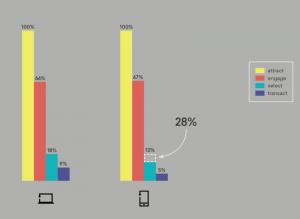By Zach Heller, Published November 3, 2014

For those of you not using Google Analytics to track your website activity, I suggest you start. Whether you’re already using it, or you’re about to get started now that I told you to, it’s important to know how to use the information Google Analytics provides.
When you’re first getting started, it can seem somewhat overwhelming. So I boiled down 5 of the most important things you should become familiar with. Here they are:
Unique Visitors
This is an easy one. Found under Audience > Overview, you will see two metrics called Sessions and Users. Sessions are the total number of visits to your site. Users are the unique visitors to your site. So the difference between the two is if someone visits your site twice in one time period, that second visit would be counted is Sessions but not Users.
When you know your unique visitors, you know your site’s traffic. You can begin to track whether that number goes up or down. For most companies, growing traffic is a high level goal. Now that you know what your traffic is, you can measure the impact your growth strategy is having.
Traffic Sources
Under Acquisition, the top three pages allow you to dig into where your traffic is coming from. The Overview page shows you at a high level where your visitors are coming from and what their behavior is once they get to your site. Here you can see the relative performance of Organic Search, Direct Traffic, and traffic from any ads you’re running.
The Channels page and the All Traffic page then provide a little more detail on that same information, breaking it into more specific categories. The key to these reports is how you use them. Not all traffic is created equal, and the information gleaned from these pages should tell you where you are getting the most valuable visitors. Focus on where you’re getting conversions and try to increase your traffic from those channels.
Bounce Rate
Bounce Rate is a metric that shows up throughout many different screens in Google Analytics. Bounce rate is the percentage of visitors who leave your site after viewing one page, whatever page it is that they land on. A bounce is a negative thing, as it means the person did not find what they were looking for and left without taking any action on your site.
You can find overall bounce rate under Audience > Overview. But the more valuable bounce rate metrics are under Behavior > Site Content. That will show you the individual bounce rates for each page on your site. I recommend using that to identify “problem” pages and seeing what actions you can take to improve the quality of those pages and get more people to stick around.
Time on Site
Time on Site is an important metric for sites that make money by selling advertising. The longer you can keep people on the site, the more ads you can sell, and the more you can charge for those ads, because you have a captivated audience. When people talk about sites as “sticky”, they’re talking about time on site.
Time on site measures the average time a visitor spends on your site. You can find it under Audience > Overview for the site overall, under Acquisition > Overview by traffic source, and under Behavior > Site Content by page. Your goal should be to grow the average time on site for every visitor by improving the quality of content on your website and making it easier for people to navigate and find what they want.
Conversion Rate
The ultimate metric is conversion rate. To measure it effectively you need to set up Goals. Goals in Google Analytics are actions that a user can take on your site that you want to measure. For example, an ecommerce site should measure sales. A blog should measure subscriptions.
Whatever your goals, you can use the conversion rate metric provided on almost all screens to track the relative success of each page on your site or each traffic source. The conversion rate will tell you of all the visitors to your site, an individual page, or from each channel, what percentage of them completed the goals you have set up.
Business Articles | Business 2 Community
(277)









